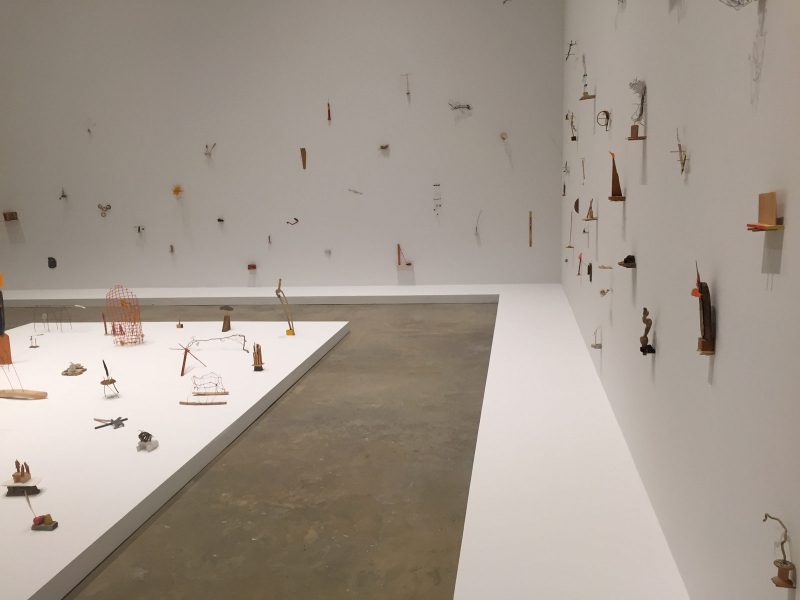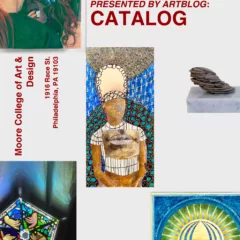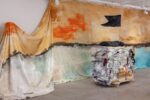
Cecilia Vicuna’s Precarios
by Levi Bentley
Cecilia Vicuña’s About to Happen, currently up at the Institute of Contemporary Art at the University of Pennsylvania through March 31, is an exercise in inversions of attention, using rescue and play as political tools. The show features pieces as serious and as considered as they are joyful, and as durational as they are ephemeral.
A collection of small delicately balanced trash sculptures, “Precarios” or as Vicuña calls them elsewhere “Basuritas,” are presented as a spell against Pinochet. They are fragile, ephemeral, precious, rough, playfully serious, risky, religious, dangerous, holy. If Pinochet treated people like trash, Vicuna treats trash like people. Each basurita has a personality, which hangs in subtle tension and relation to the rest. The use of space between them is postmodern, echoing Kandinsky and Miro in the emphasis on white space. It creates a sense of isolation, which amplifies the tenuousness and lack of sculptural durability of each piece. They go on for so long, the collection of basuritas scattered carefully over a low wide plinth and hung floor to ceiling on two gallery walls, that they gesture towards infinity, an infinity of possibility, an infinity of fragile isolation, an infinity of little resistances that starts to look like a movement. Each, a little religious object, a prayer, a poem. She describes her practice with these pieces as “hearing an ancient silence waiting to be heard.”
Each precario moment is composed of three or four pieces of detritus, combined through Cecilia Vicuña’s attention, to create a fragile little group identity, loosely joined into a totem. A few little weathered triangles of plywood, some edges of weathered paint, begin to look like a family of ducks. A small piece of driftwood with three thin spines rising out of it, one supporting a spiral of bent wire, the other two supporting more fragments of twine or wood, has the air of a tiny runic fishing vessel. These float in the white space of the plinth amid a sea of islands of other little totems, each one an improbable contrast of color and material. A little shard of joy, of faith. The show has been accumulating since 1977, has been growing up to the present. It represents not only a project but carries with it the weight and depth of long practice.
“Balsa Snake Raft to Escape the Flood,” a sister piece created from detritus gathered in the aftermath of Katrina, contains the same respect for the mundane and magic of the materials. The echoing of formal moments, the undulations of suspended sections of rope, the interconnectedness of the wood being woven into the beginnings of a raft, has the effect of a piece of music on loss and promise. The salvaged wood is not varnished, the ropes are faded and dusty, the bouys of chipped styrofoam seem no more shaped than by the wear and weather at the time of their discovery. The materials are not transformed, but given the dignity of their natural states, brought into new relationship.
The gallery contains a combination of other experiments, poems, objects. Video footage of raw wool lowered down the outside of an apartment building which breaks and undulates towards the camera lens. A case containing a series of small book experiments, including “libro de errores,” a tiny publication of handbound scraps of typewriter correction paper, with the negative space of the letters typed out of white correction material. A large quipu hangs on the wall, a new interpretation of an ancient indigenous form of communication. It is raw wool with typewritten letters painted on it, connecting the histories of text and textile.
In both “Precarios” and “Balsa Snake Raft,” Vicuña has resisted transforming the materials into a polished, spectacular product that obscures the material’s origins, or each shard’s individual qualities. The magic of these new relations is that they are attentive to the original form and materials of the ephemera. The way they are brought together is reminiscent of the beginnings of the twitching of the shards of broom in the Magician’s Apprentice, the disney movie where a thousand shards of wood rise up to become an army of brooms. The discarded and destroyed come back together to gather for the overturning of the power which has destroyed and scattered them.
What’s stunning about this work is that it is formal and conceptual while being deeply humanizing, attentive and playful. It does not rely on violation or provocation in ways that echo existing structural inequities, or draw attention to trauma without critiquing it like so much conceptual work created within the context of the United States. Instead, it is attentive, compassionate, and dwells on the connection between human and environmental crises. It has an unambiguously revolutionary horizon.
Cecilia Vicuna’s About to Happen at the ICA rhymes with the Tony Conrad retrospective downstairs in it’s investment in the quotidian as a place of value, play, building, and aesthetic pleasure.
The way the “Precarios” and “Balsa Snake Raft” pieces speak to revolutionary possibility and dream towards a future rising from the wreckage is not the rhetoric of political domination, the shiny technocratic “luxury gay space communism” (although it is certainly not incompatible with these) but a space for silence, prayer, a whisper of joy, a small gesture towards relationship, intimacy. A future not triumphant in obscuring the devastation, but built from within and in full acknowledgment of disaster.
In a moment of political intensity in the United States, in which the political reality and the demand for modes of resistance feel like an emergency, and yet are coupled with exhaustion and confusion about how to move forward, these works feel fresh and self-assured. They are a philosophy, a poem, a way of being that introduces a humble but brave, iterable, way of practicing hope that feels possible and demonstrates clearly it’s own cumulative power.
It demonstrates the possibility of a life of resistance, beauty, intimacy, and meaning built of small discarded things. It revalues the discarded as centers of a religious investment in listening and daily, interpersonal knowing and resistance. Maybe within the possibility of seeing a single piece of grass as a totemic element, there is also the possibility of reinvesting in one-another, the embattled and weathered detritus of capitalism, heteropatriarchy, and white supremacy. The possibility of finding beauty and strength in the quotidian relationships rather than the facilitated glossy revelations of streaming video, or calculating the accelerated rising to fame and falls from grace of people struggling to find value through social media. Vicuña shows us that no devastation is complete, that nothing is so blasted the beauty and meaning cannot take root. This is not to obscure the larger tragedy, but to find a basis for the seeds of resistance, the modest beginnings, the small repeatable practice of joy, attention, and intimacy which will be the center of any manifestation of political healing and change.
Bio
Levi Bentley is a 2019 LAMBDA Literary Fellow, Director of Pedagogy for Blue Stoop, and 2017 Leeway Art and Change grantee. They live in Philadelphia where they make chapbooks with Ted Rees under the imprint Asterion Projects. Poems from “Bucolic Eclogue” were released by Lamehouse Press in 2016. They have also released chapbooks through 89plus/LUMA Foundation, Damask Press, and Well Greased Press. Poems have appeared in Apiary, Bedfellows, BlazeVOX, Elective Affinities, Fact-Simile, Painted Bride Quarterly, The Rupture, Stillwater Review, The Wanderer, and a variety of other venues.
levibentley.com
instagram: @speakwright
twitter: @speakwright









